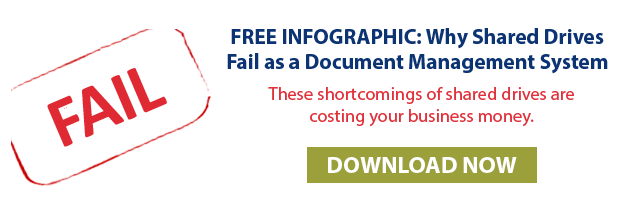 The digital age is upon us and many companies are struggling to decide the way in which they are to solve the “paperless document storage” issue. How are we going to control and manage our documents if we truly no longer print and file documents in our workplace?
The digital age is upon us and many companies are struggling to decide the way in which they are to solve the “paperless document storage” issue. How are we going to control and manage our documents if we truly no longer print and file documents in our workplace?
There are many opportunities, these days, to choose secure options of onsite digital document storage. Servers and shared drives being the main forms. There are however, many more options for online-cloud-based-digital data storage and document control.
I had a company ask me a few weeks ago how-to setup a newly acquired document server drive. As her business mentor, I did advise her that for security sake she should choose a cloud-based option or at the very least, an offsite option. When she asked me why she needed an option like cloud back-up and storage or an offsite server; I sat down with her.
My friend (call her Liz), she has been my mentee for many years. Liz is an older woman trying to keep up to the times of this changing technology age. She gets technology, you just have to “write it down on paper for her”.
Liz has been changing to the digital times for over 10 years now. As a point of fact, Liz just purchased her very first computer back-up system. I helped her hook it up and made sure it was backing up her files right away. (Because some form of computer back-up and file retention system was better than none.) I then took that trusty old pen and paper and drew Liz a picture of what the new hardware was doing for her software!
During my discussion with Liz, I talked about the advantages and disadvantages of the “docu-server”. First, a single drive document server is never recommended by a professional, unless you live way out in the “boon-docks” with little to no access to the internet and absolutely no other option.
Here are just a few reasons why you never want a single drive - company back-up and file server system:
- Where is your data security? One hard drive has no on-board intricate security to make you aware if your systems are being “hacked”.
- Single drives are easy to misplace or get stolen. What happens then, to those sensitive files?
- Single hard drives fail regularly. If the drive fails, you are immediately removed from your data.
- Single drives hooked-up to a network of computers do not sync all the files when changes are made.
- Single drives, because of their size can easily become damaged if dropped when transferring from one employee to another. Again, say “goodbye” to those files.
- Single drives – even in a document server cannot have more than one person at a time in any given file.
The only way to make sure all the correct information is in a document on a single hard drive, is to have the person using the document, save it as a revision, close the document and then allow the next person into the file.
Though it is true that saving a document as revision is a good idea, it does lead to a complicated issue as to what revision you are supposed to be working with, so everyone is on the same page when it comes time to implement the work, (which is the sole reason for the document).
When a drive is dropped and cannot “spin-up”, it can make it almost impossible to retrieve your data. Specialty date-retrieval people are sometimes hard to come by and/or they are very expensive and charge by the hour!
These problems are slightly lessened if your document server has multiple drives and those drives are “raided” together. (That might be a topic for another day!)
Once I was finished with my friend Liz, I decided it was time to reintroduce myself to some better options for data storage. And as a business mentor, that meant researching more secure technology and asking myself a few key questions:
- How are existing businesses currently dealing with their data?
- Is their data still wrapped up in the backroom filing cabinets? Crammed full of files which are incorrectly stuffed into gorging folders? Maybe these corporate files are stored in on-site archives or are the files stored at an offsite facility (again, a topic for another day).
- What about secure file shredding companies? Are these still going strong, or were they a stop-gap measure to recycle the paper files a corporation can go through in a year?
- If their data is all digital, how are their digital files currently filed? On their own corporate server or perhaps at an offsite data farm?
First things first. I have seen the amount of paper my own small company has generated over the course of one year. One year with only a few companies to service under my own Mentoring banner. No inventory and only, what I thought were a few files printed weekly. By the end of my corporate business year, my two full size filing cabinets were stuffed to where I would have to remove them from my office site to my storage site, in what amounted to approximately 10 to 12 banker’s boxes per year. After my first five years in business, I was forced “by my papers” to rent a larger storage unit.
After a little research, I found out that most corporations have had to store their yearly files in large onsite corporate archives or off-site Document Warehouses. After the required six or seven years, the documents could be removed and destroyed. But only the Corporate Tax documents.
The CRA (Canada Revenue Agency) mandates corporate files are to be kept for a minimum of six years. Longer if you have been audited and are appealing the audit results.
In the U.S., the IRS (Internal Revenue Service) mandates corporate files be retained for seven years and longer if you have been audited and are appealing the audit results.
Both of these governmental bodies state that only the Corporate Income Tax files and supporting documents need to be kept for the required time listed above. What about the documents that don’t have anything to do with Corporate Taxes? Now here is where the fun begins!
My research led me to learn that from an HR standpoint, employee tax records must be kept a minimum of 4 years. While corporate contracts to do with any kind of property are to be kept for a minimum of one year after the completion of a contract or the disposal of that property. I have seen property contracts go back 20 years!
“What ifs?”
Your corporate building has a fire. The Archives are affected, not by the fire, but by the fire suppression system. Now what? Perhaps, instead of a fire, there is a flood. Same result. What about the “Devil’s Advocate”? You believe your corporate archives are safe in the onsite archive area. You find a breach of security, either internal or external, same result. Maybe it gets complicated because identities of your clients are compromised. It happens! Even to the Government!
What could be the possible implications of destroying documents, via shredding and/or incineration? Well, I know that document shredding trucks are still a “staple” in the business world. These trucks come to the business, and shred old documents right at the business, so the business is aware the documents are shredded securely. But what if some of those pieces of private papers get missed and end up floating down the street?
I cringe just to think of that happening! With incineration, files are loaded into an incinerator while still in the banker’s boxes. Which is fine if the boxes haven’t been compromised, which as I am sure you are aware, happens more often then we care to admit. I am sure more than one or two pieces of paper have gotten away from the incinerator as well.
Ok, so all your data has been safely digitized. Confident you have everything in your onsite server, including everything from corporate income tax and supporting documents to last year’s team Christmas party invoices and receipts. You feel you have truly gone paperless. How safe and secure is your data? Your onsite server is more of a data storage unit. You have access to your files, but the corporate data filing system is contributed to by everyone in the corporation. From the mailroom, on up to the CEO. How structured will your files remain after a week, month or year of multiple data filing sources?
These data files are filed by the same people who used to file your hard copies. We all know that even with just one human filing the entire system, files get misplaced. Multiply that by the number of people contributing to the data filing system, and you have an intricate mess in no time. That is not even counting the duplicate files which occur regularly. Even those Revs that I mentioned earlier. Before long, your corporate server has been corrupted by humans! Humans, doing nothing more than they are supposed to do while filing.
What about malware and virus packets? Again, intrusion by theft of the data? Fire or the fire suppression system? You think your data is safe: But is it? Onsite storage or offsite digital data storage facilities; both can have security breaches.
During the course of my research, I came to see for myself, how much technology had changed in the few short months that I had been otherwise engaged in my life.
Today there are companies whose sole business revolves around cloud-based document storage with proper document serving capabilities along with proper security factors.
Companies whose software can take a scanned in document or even a picture of a receipt, and if it is an invoice or receipt, can classify it, account for the numbers and add it to your accounts payable or accounts receivable and equalize the accounts. Even if the document is not to do with accounting, it can manage the revision factors of multiple users at the same time!
Yes, times are certainly changing. When you think about differences from 2017 to 2018, with respect to the latest cloud-based technology; it is easy to identify those who are now “living in the past” because of the push for companies to define the difference between “Cloud-based document storage” and “Cloud-based document server capabilities”.
Just last year my husband finally got me to switch from our high-end document and entertainment server (The home server we had paid in access of $3000 for only a few years ago), to an online document service package.
My hubby is an Excel Guru, but even he cannot make an indexing macro to help locate our files on the home server. He can tell me every last file on my server, but he cannot catch duplicate files at the press of a button. Since our switch, I have been able to identify duplicate files and reconcile them without having to open them all up and peruse them for content.
I really didn’t see what all the fuss was about. It was sometimes difficult to access my home server from outside my home, but not impossible with a good Wi-Fi signal. There are literally terabytes of entertainment files we have on our home server, and barely 100 Gigabytes of actual document files. However, until this all happened, I didn’t realize how easy it was for me to obtain the use of my documents when I was away from the house, until we loaded those documents up to “the Cloud”!
Looking back now, to the days not so long ago, when a shared drive was all we could afford, it was difficult for us to maintain any form of document control. My husband works away from home for many weeks at a time. Even combining the drives when he returned home was difficult. It meant that one of us, usually me, would have to go through each file and zero-in on who made the last change to any given file.
Next came the job of finding the changes made to both and be sure we each had the same information. It would literally take the entire time he was home, just to marry two files at a time. This meant there was less time to actually discuss the business and family issues.
Now, no matter where I am and even if I do not have my laptop, I am still able to access and use my documents
and my software! My husband and even my employees can all access documents and the company software at the same time, make changes and I don’t have to worry what Rev. I am on, because specialized software takes care of that for me! I even get updates if after-hours the files are in use. Unfortunately, the files are generally being used after hours by yours truly!
I am so impressed with the way my documents can be searched by keywords I incorporate into the documents. I like the computerized interface that directs my files and how my files are no longer on this computer or that one. I can remember how only a couple years ago, when single drives and home servers were all the rage, how I thought it was great to just have a central storage that we ran from another computer.
The interfaces we were able to use, were my husband and I remote desktop(ing) into the server to find our files. The only meta data that we ever worried about, were the digital photographs I have taken over the years as a Professional Photographer.
Entertainment wise, our home server is still a great media server. Now, however, even that avenue of technology has rocketed into 2018! I can now go anywhere and as long as I have a cell signal, I can stream Netflix, or FaceTime my son, living in Ottawa, Ontario. I can upload a video to YouTube and have friends in Sweden enjoy the show!
Technology is the new “Iron-Age”. With personalized cloud-based document control, which works just as well for the private citizen, as it does for the multinational companies, and cloud-based document storage, the only issue I can foresee can occur, comes into play when there is no internet out on a jobsite because you are in the middle of the bush at a mobile jobsite.
Other than this scenario, I don’t think business today will be going back to the “one-drive-wonder” for document storage. That is; unless you are my friend Liz!


